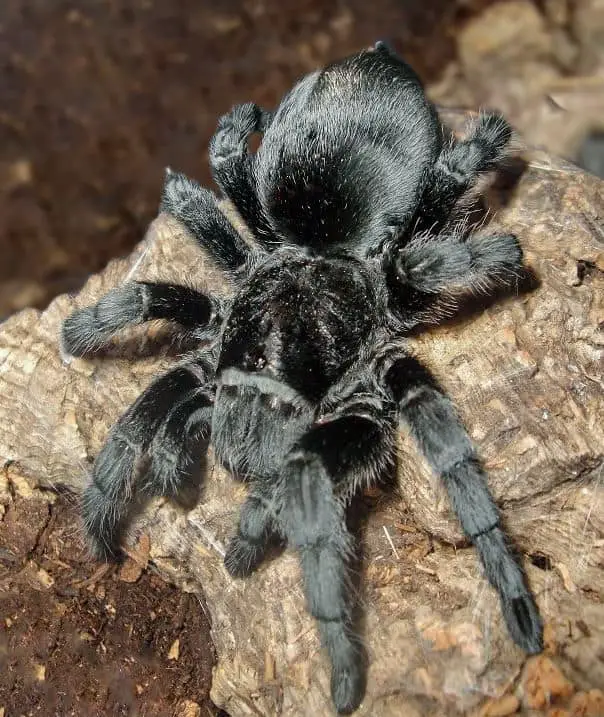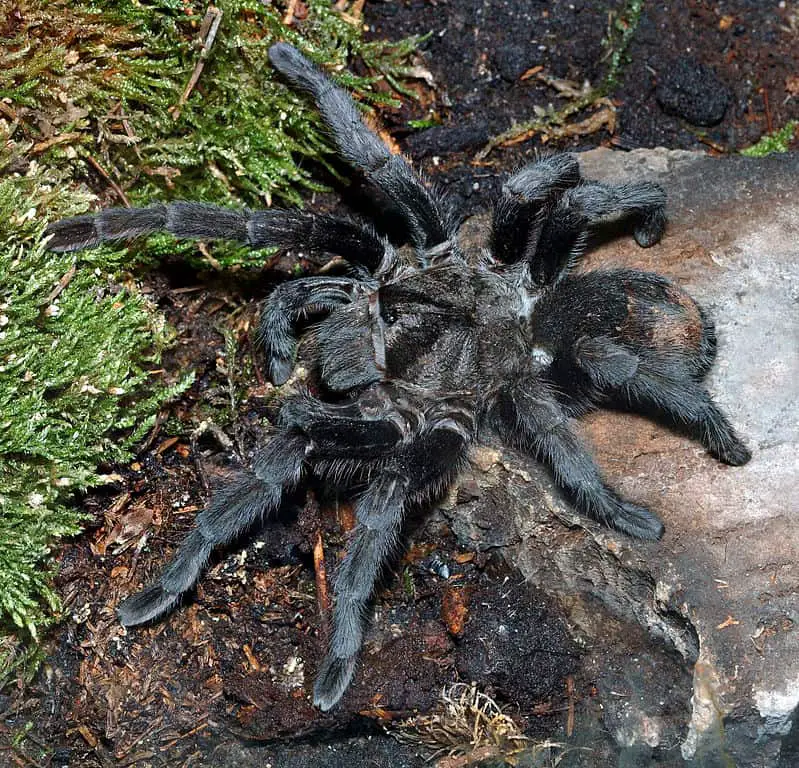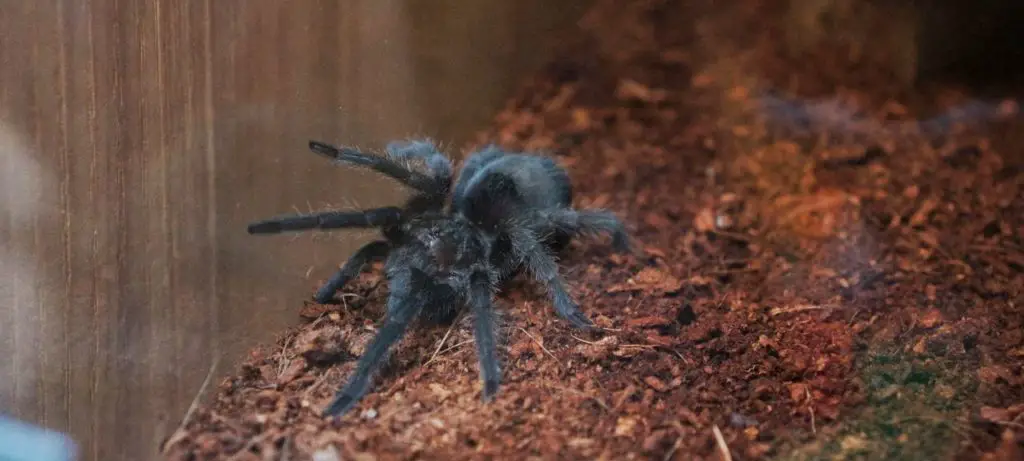The Brazilian Black Tarantula (Grammostola pulchra) is a terrestrial New World species native to Brazil. It’s highly desired among hobbyists for its jet-black body, docile temperament, and long lifespan.
Their docile temperament in combination with their non-potent venom also makes them a very suitable species for beginner hobbyists.
If the Brazilian Black Tarantula has drawn your attention and you’re considering adding this beautiful species to your collection, here’s everything you need to know about them!

Brazilian Black Tarantula Care Sheet
| Name of Species | Grammostola pulchra |
| Family | Theraphosidae |
| Common names | Brazilian Black Tarantula |
| Native location | Brazil, Uruguay |
| Category | New World |
| Type | Terrestrial |
| Leg span | 7 to 8 inches |
| Growth speed | Slow |
| Urticating hairs | Yes |
| Diet | Insects, primarily roaches & crickets |
| Social | Solitary |
| Temperature | 75 to 85 °F |
| Humidity | 60 to 75% |
| Life span | Females: 20 years / Males 6 to 8 years |
| Experience level | Beginner |
Brazilian Black Tarantula Overview

The Brazilian Black Tarantula, also known scientifically as the Grammostola pulchra, is a large New World tarantula that’s native to Brazil and Uruguay, where it lives on the forest floors.
As opportunistic borrowers, they create their homes under twigs, roots, and rocks, which they use as a starter burrow. Then they line this burrow with silk to help them ambush prey.
Appearance
The name “Brazilian Black” gives an apt description of what this spider looks like. As adults, they’re almost completely black in color and covered with hairs that give them an incredibly smooth appearance.
Males and females of this species look very similar to one another. The primary difference is that females are typically a bit bigger and males have tibial hooks which they use to block the female’s fangs when they’re mating.
As slings, they’re typically very light in color and they don’t get their characteristic velvety black coloration until they’re fully grown.
These arachnids can grow to a maximum size of 8 inches, although they more commonly grow to a size of 6 to 7 inches.
Price
The Brazilian Black Tarantula is a relatively expensive species.
Slings can easily go for over $100 each, while females can go for prices of around $300.
Females are typically more expensive than males due to their much longer lifespan.
Behavior & temperament
The Grammostola pulchra is characterized by its docile and calm behavior. They do have urticating hairs, but they do not have a tendency to flick them off their abdomen.
Furthermore, while most tarantulas are very fast movers, the Brazilian Black is relatively slow. They have a tendency to move around slowly which makes them much easier to handle.
Of course, they do have fangs and like all tarantulas, they are venomous.
Luckily, they’re very unlikely to bite, and even if you do somehow manage to get bitten their venom is very weak. It has about the same potency as a bee sting, so it’s nothing to worry about if you’re not allergic.
They’re also not particularly shy, and spend quite a bit of time outside of their burrow, which makes them very easy to observe in their enclosure.
Handling
If you choose to, you can handle the Brazilian Black. Their docile temperament means that they tolerate being handled quite well.
Do be cautious though that you do not startle them when handling them. When startled, they have a tendency to run away, which can lead to them falling off your hand. Falls are dangerous for tarantulas, especially for terrestrial species. It can lead to their abdomen rupturing which can be fatal.
Furthermore, you should make sure that you do not hold them close to your face. Their urticating hairs aren’t all that dangerous if they touch your skin, but if you get them in your eyes, mouth, or nose, they can do serious and permanent damage.
It’s also for that reason that it’s crucial that you properly wash your hands after interacting with them. The hairs can get stuck on your hands and if you afterward touch your face you can accidentally spread the hairs to your eyes, nose, or mouth.
Lastly, keep in mind that while the Grammostola pulchra is a relatively docile species that tolerates being handled, they do not necessarily enjoy it. Spiders are not affectionate animals and they prefer to be left alone. It’s fine to handle them occasionally, but do not do it too often.
Caring for a Brazilian Black tarantula

Tarantulas are very low-maintenance. As long as you provide them with a nice enclosure that has a good temperature and appropriate humidity, food, water, and quality substrate they will be more than happy.
Here’s everything you need to know to allow your spider to thrive.
Tank setup
As a terrestrial species, the Brazilian Black needs a terrarium that prioritizes horizontal over vertical space. Ideally, they need an enclosure that has 2 to 3 times as much vertical space as their leg span.
So, if you have a 7-inch Brazilian Black Tarantula, give them an enclosure that has about 18 inches of vertical space.
Height is not as important. As long as the enclosure has enough height so that you can place enough substrate in it and still have enough space left over for your spider to walk around without being cramped, they should be fine.
Slings can of course be housed in much smaller enclosures as long as you make sure that you rehouse them whenever they grow too big for their old enclosure.
As opportunistic borrowers, you should provide these spiders with a starter burrow. You can do this by placing a piece of hollow cork bark or anything else that’s suitable as a hide halfway into the substrate. Your eight-legged friend will gladly take this starter burrow and create their home in it.
You can also make the enclosure more appealing by placing some rocks, and artificial or live plants in it. This will also make your spider more likely to venture out of its burrow to explore. A bioactive enclosure is ideal for them, but this can be hard to achieve.
Ventilation is also very important. To achieve proper ventilation, either buy an enclosure with air holes in the sides or drill them in yourself.
Substrate
For terrestrial borrowers like the Brazilian Black, substrate is very important. You have to make sure that they have a layer of substrate that’s at least 4 to 5 inches thick to give them adequate space to burrow.
Good materials to use as substrate are coconut fiber, vermiculite, peat moss, topsoil, or a mixture of these materials.
Temperature & Humidity
The Brazilian Black Tarantula does best in temperatures between 75 and 85 degrees Fahrenheit. However, their natural climate fluctuates between 65 and 85 degrees, so they’ll be able to survive in these temperatures.
If you live in a cold climate and feel like you need to provide supplemental heating for your spider it’s important that you never place a heat mat under the enclosure.
This is a bad idea because tarantulas have a natural instinct to dig down to cool off. If you place a heating pad under the enclosure it will get warmer as they dig down while they’re trying to cool down.
Instead, if you feel like you need to give them more warmth, place a heating pad at the side of their enclosure. That way, the spider can move closer or further from the heat as they please.
As for humidity, they do well in enclosures that have a relative humidity of 60 to 75%. Keep in mind that ventilation is also important to avoid the growth of bacteria or mold.
Social
While some tarantula species can be kept communally, the Brazilian Black is not one of them.
In the wild, they only meet others of their species when it’s time to mate. Even then, the females often try to eat the males, which is why the males have evolved tibial hooks to protect themselves.
In captivity, you shouldn’t place more than one of these spiders in the same enclosure.
Feeding
The Grammostola pulchra has a decent appetite and will easily take down any prey that’s smaller than itself. They’re carnivores that should be fed an insect that consists primarily of a variety of different insects.
As slings, they should eat flightless fruit flies, cricket legs, or other parts of pre-killed insects. At this stage, they should not eat large, live insects yet because they’re too small and weak to be able to overpower them. You can feed slings as much as you want because there’s no real risk of overfeeding them. Just make sure to remove any food that they do not eat within 24 hours.
As they grow bigger and enter the juvenile stage of their life they can start to eat live prey. Good prey items to feed them at this stage are small to medium-sized crickets or mealworms. Make sure that any prey you offer them is smaller than their abdomen so that they can easily eat it.
As adults, they can eat pretty much any insect that’s small enough for them to overpower. Insects that they can eat include locusts, dubia roaches, mealworms, superworms, and crickets. The majority of their food intake should come from roaches and crickets since those are best for them, but other insects can be offered once in a while to spice up their diet.
Some people choose to feed mice or small lizards to their spiders. However, this is not really the best idea. Not only can these animals easily bite your spider which can do serious damage to them, but they’re also very high in calcium which is not necessarily very good for them.
They’re perfectly content eating insects their entire life, which is what most owners feed them.
An important thing to note is that they typically stop eating right before a molt. This is normal behavior and nothing to worry about. They do this because it makes the molting process easier.
Furthermore, right after a molt, you should avoid feeding them at all for a few days because they cannot eat until their fangs have hardened.
Watering
Your Brazilian Black Tarantula should only drink water. Make sure that adults have access to a water bowl that’s filled with fresh water at all times.
Slings that are very small will drink droplets that they find in the enclosure. To provide them with these droplets you can spray the sides of the enclosure. The droplets will then drop down, where the slings will drink them.
Lifespan & Health

The Brazilian Black is a hardy, healthy tarantula species. If you treat them right, in captivity, there’s not much preventing them from reaching their full lifespan of 20 years for females and 6 to 8 years for males.
To keep them healthy, there are a few very important things to take care of:
- Mold/bacteria
- Spider mites
- Parasites
- Falls
These are the only real threats to them in captivity, here’s how to prevent them from harming your eight-legged friend:
- Mold, bacteria, and spider mites can be prevented by keeping their enclosure clean and providing them with ample amounts of cross-ventilation. Remove uneaten food within 24 hours and replace the substrate when needed. A bioactive enclosure also goes a long way in preventing these problems.
- Parasites can be prevented by only feeding them captive-bred insects. Wild-caught insects are often infected with parasites that can spread to your spider through feeding.
- Falls can be prevented by making sure that your tarantula’s enclosure does not have too much height and by being very careful when handling them.
Facts about the Grammostola pulchra
- This species was first described in 1921
- The female G. Pulchra can lay up to 600 eggs in one egg sac.
- Their venom is very weak
Final words: is the Brazilian Black Tarantula right for you?
Whether you’re new to the world of tarantula keeping or have already cared for dozens of spiders, the Brazilian Black has something to offer to hobbyists at any level.
Their stunning appearance combined with their docile temperament and large size means that you can’t go wrong adding this species to your collection.
They tolerate being handled fairly well and as long as you give them the care, enclosure, food, substrate, and water they need they can have incredibly long lifespans.
- How Long Do American Eskimo Dogs Live? Important Factors and Care Tips - September 29, 2023
- Do American Bulldogs Need Grooming? Essential Tips and Care Guidelines - September 29, 2023
- Do Bengal Cats Enjoy Playing? Essential Tips for Keeping Them Active - September 29, 2023